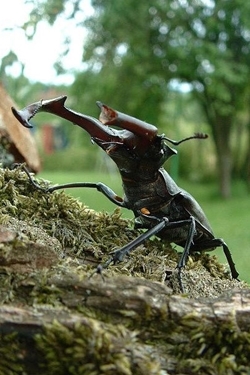Stag beetle
 If you don’t like creepy crawlies, then the sight of a large male stag beetle (Lucanus cervus) is probably going to send you into apoplexy! This condition might not be helped much by learning that this beetle also goes by the vernacular names of billy witches, oak ox, thunder beetle and horse pincher! Also, and just to finish off your nightmare, it was thought in the past that “these beetles can be suspended from the neck of infants by way of remedy against certain maladies”!
If you don’t like creepy crawlies, then the sight of a large male stag beetle (Lucanus cervus) is probably going to send you into apoplexy! This condition might not be helped much by learning that this beetle also goes by the vernacular names of billy witches, oak ox, thunder beetle and horse pincher! Also, and just to finish off your nightmare, it was thought in the past that “these beetles can be suspended from the neck of infants by way of remedy against certain maladies”!
The male stag beetle uses its characteristic antler-like mandibles in courtship displays and to wrestle other male beetles, and is in my opinion a very fine creature. He can be around 3 inches (7.5cm) in length and emerges about a week before the female beetles, using this time to establish his territory. He then spends the rest of his life flying around his territory, mating and fighting off any potential challengers.
The female beetle, on the other hand, doesn’t have the large mandibles and is generally smaller than her male counterparts, measuring somewhere around 2 inches (5cm). She can fly but spends most of her time walking around and mating. Her final act before she dies is to make her way back to the place from which she emerged, where she buries herself into the ground to lay up to 20 eggs, starting the cycle all over again.
Larvae develop in decaying tree stumps and fallen timber of broad-leaved trees in contact with the ground, especially of apple, elm, lime, beech and oak. In fact, sometimes they are not that fussy and will use the buried part of a fence post or old rotting logs at the bottom of a woodpile.
The larvae eventually become large (fully grown, they can reach 3 inches (8cm) in length), fat, white grubs with an orange head. Remarkably, we all tend to get excited when we see the adult beetle, however stag beetles only live for around six weeks as an adult, yet spend some five or six years underground as a wood-munching grub.
Stag beetles pupate in the autumn of the year before they emerge as beetles. However, they only remain as pupae for a few weeks. During the following weeks, the outline of a fully developed beetle gradually begins to appear beneath the skin. Eventually, the pupal case will split and the beetle will crawl free. However, it will remain underground as a fully formed beetle throughout the winter, only emerging once the warm sunshine of early summer arrives.
They may look fearsome when they eventually emerge as an adult beetle, but unfortunately not frightening enough to stop a host of birds eating them, in particular carrion crows, magpies and kestrels. Humans, too, can be an issue, as adults often seem to want to crush them as they think that they might be dangerous, while children want to play with them, poking them about or even taking them home to become a pet!
If you live south of a line from Yorkshire to Worcestershire, keep an eye out for this remarkable beetle. Perhaps I should also take this opportunity to remind you that they are also classed as a ‘protected species’, listed on Schedule 5 of the Wildlife and Countryside Act 1981, and so it is an offence to interfere with them. So no crushing or pet-making, please!
Peter Thompson
Advisory
Read more from Peter Thompson at his blog.

Download Peter Thompson's essential 26-page book, featuring beautiful photography and detailed profiles of Britain's wildlife
Download FREE >